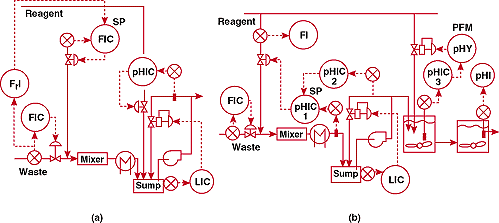
pH Control: A Magical Mystery Tour
Systems for pH control are characterized by extreme rangeability and sensitivity, and are also subject to difficulties arising from contact between measuring electrodes and hostile fluids. Case histories of representative installations show that success in implementing these control systems depends not only on assessing the complexity of the loop and selecting a control strategy but also on recognizing and avoiding pitfalls while specifying and installing instrumentation, equipment, and piping.
I do not pretend to be the world's champion pH problem solver. But, I have helped rescue over 50 foundering pH control systems in the past 5 years and am still rational enough to tell you about it. Most people hardly notice that I twitch at the mention of hydrogen ion concentration.
WHY IT'S A PROBLEM
Why is pH control a problem? After all, you've got an odd but simple scale of measurement from 0 to 14 dimensionless units, measuring electrodes that have been around long enough to be well understood and readily applied, and instrument vendors who must have seen every possible application by now.
Rangeability and Sensitivity
One basic source of difficulty is that - as countless articles, technical papers, and textbooks point out - the pH scale corresponds to hydrogen ion concentrations from 100 to 10-14 moles per liter. No other common measurement covers such a tremendous range. Another intrinsic constraint is that measuring electrodes can respond to changes as small as 0.001 pH, so instruments can track hydrogen ion concentration changes as small as 5x10-10 moles per liter at 7 pH. No other common measurement has such tremendous sensitivity.
The implications of such great rangeability and sensitivity can be illustrated by considering a continuous feedback neutralization system for a strong acid and a strong base. The reagent flow should essentially be proportional to the difference between the hydrogen ion concentration of the process fluid and the setpoint. A reagent control valve must therefore have a rangeability greater than 10,000,000:1 for a setpoint of 7 pH when the incoming stream fluctuates between 0 and 7 pH. Moreover, uncertainties in the control valve stroke translate directly into pH errors, such that hysteresis of only 0.00005% can cause an offset of 1 pH for a 7 pH setpoint.
The situation is like playing golf. The distance from the tee to the green represents rangeability and the ratio of the hole diameter to this distance is analogous to sensitivity. For an application requiring a strong base to neutralize a strong acid or vice versa, the tee would be about 1,000,000 yards from the green and the hole would be about 3-1/2 inches in diameter. A hole-in-one is impossible. And using the same size control valve at each stage would be like hiring a gorilla to drive the ball to the green in one stroke, then finding that it tends to overshoot the hole on the putt.
How is it even possible to control a process under these conditions? Rangeability and sensitivity limitations can be overcome by approaching the setpoint in stages, using successively smaller control valves with high performance positioners.
The real world
A host of other constraints adds to the difficulties of pH control. These range from the necessity of wetting the electrodes - with consequent susceptibility to leakage and attack by the fluid, to long delays introduced by the need to mix large volumes of process material with small amounts of reagent. Even with a good understanding of measurement and control concepts, these real-world effects introduce an element of magical mystery into pH.
|
TABLE I. The Facts of Life
|
SOME TYPICAL PROBLEMS
No pH complications are really typical. And the systems that are easy to implement don't get referred back to those of us whom InTech refers to as the noodnicks from Central Engineering. But the installations I will describe are typical of those I have encountered recently, and illustrate the types of problems that you can expect.
To avoid arguments with our Legal Department about proprietary information, I will not mention any places or names; I'd even prefer that you forget my name when you finish reading. Also, to help guide you through my tribulations, and those you will encounter yourselves, I've prepared Table I, enumerating what you can think of as the Facts of Life. Commit this Table to memory; you'll be quizzed on it in the morning.
Where's the tank?
An application involved a strong acid waste flow, to be neutralized by a strong basic reagent. It was called in because the pH was swinging from 0 to 14 despite efforts to tune the controllers, manually manipulate the reagent, and regulate the influent flow. When I got to the plant, I gazed over the horizon and didn't see any tanks. I suddenly realized that I had a major problem.
Figure 1a shows the original control system. This used a ratio controller to proportion reagent to acid waste flow upstream of an in-line mixer. A separate pH controller was used in a loop on a sump. The system designers did not realize that the flow measurement error and the flow control valve hysteresis must both be less than 0.00005% to stay within 1 pH of the 7 pH setpoint. They assumed that disturbances would be small since the change in waste composition was slow and its flow was fixed by a controller. The design team did not know Fact of Life #1.
A system involving a strong acid and a strong base normally requires three stages of control to hold a solution within 1 pH of 7 pH (Ref 1). Since cost was stressed as a factor, I kept the existing mixer and sump as one stage and added two vertical well-mixed tanks downstream for the second and third stages. Further, I agreed to not install controls on the third stage until the need was demonstrated. The third stage volume therefore served as a filter for the oscillation from the second stage.
For the first stage of control, we started by replacing the ratio flow system with a fast inline pH loop. This received a remote setpoint from a second pH controller on the sump. The fast in-line loop would initiate the correction and depend on the sump volume to average out hydrogen ion concentration deviations. Linear control system analysis predicted that this combination would be as effective as a single well-mixed vertical tank. It didn't work. Dynamic simulation showed that the in-line loop would oscillate between 0 and 14 pH for all controller settings. A plant test confirmed the result.
At first, I thought the sump was somehow not providing the anticipated filtering. Then I remembered Fact of Life #2. The filter was acting on hydrogen ion concentration, not pH. The sump was attenuating concentration oscillations by a factor of 100, but is corresponded to a decrease of only 2 pH. Attenuation was improved by reducing the distance from the mixer to the control valve and electrodes so the oscillation was faster.
The second state had a notch-gain pH controller was an output that provided a pulse frequency proportional to an analog signal. Above 25% controller output, the valve was throttled normally; below 25%, valve rangeability was extended using pulse frequency or interval control.
Figure 1b shows the upgraded installation. This system could keep pH within the desired offset band at the outlet of the third stage. However, the sump controller was difficult to tune and recovery from startup or waste flow controller setpoint change was slow.

FIGURE 1. Where's the tank? (a)-unsuccessful and (b)-successful pH control systems for a continuous neutralization process initially having no mixing tank.
If I were designing this system today, I would place a feedforward loop on the sump and would install controls on the third stage. I would also characterize the feedforward and feedback signals. The characterization would involve calculating reagent demand from the pH measurement using the titration curve, and using the result as the control command. This would reduce nonlinearity, recovery time, sensitivity, and tuning difficulty. Microprocessor-based controllers can provide the necessary calculation accuracy and ease of implementation.
As with any new system, startup was not without bugs. Some were of the common garden variety - like transposed wires and incorrectly calibrated positioners. Others were of the magical mystery type peculiar to pH systems.
For example, at high pH levels, the measurement went downscale as the strong base reagent flow increased. As you can imagine, this drove the control system - and us - kind of crazy. The difficulty turned out to be that the measuring electrodes in the in-line loop were not specified with high-pH glass. Normally this would cause the measurement to read low by about 1 pH at the upper end of the scale. In our case, it caused a reversed response. This performance was confirmed by the vendor, and was corrected by replacing the electrodes with low sodium ion error devices.
Another magical mystery effect was that the electrode response for the well mixed tank became erratic. We found water on the terminals inside the submersion assembly. The vendor told us if we bought an assembly that cost twice as much, the leakage would stop. We did; it didn't. The vendor then told us to buy a newly developed assembly, for four times the price of the original and the leakage would surely stop. Rather than make the same mistake three times, I shopped around and found a throwaway electrode assembly completely encapsulated in plastic - at half the price of the original. It worked like a charm. A similar experience with a submersion assembly from another vendor led me to Fact of Life #3.
Where's the valve?
Another application required small quantities of a highly concentrated viscous reagent for continuous neutralization of a waste stream. The control system was so slow that disturbances passed through the plant long before any corrective action took effect; further, the pH trend recording had a noise band that far exceeded the allowable setpoint offset. When I inspected the system, I stood near the injection point at the inlet to the pipeline mixer, scanned the horizon and didn't see any reagent control valve. I quickly deduced I had a major problem. Figure 2a shows what I found.
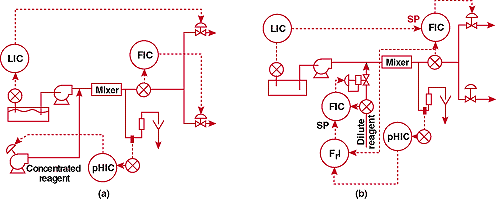
FIGURE 2. Where's the valve? (a)-unsuccessful and (b)-successful pH control systems for a process involving a highly viscous concentrated reagent.
Can you spot a control problem exclusive of the pH loop in this figure? The sump level controller sets the flow in the upper outlet branch. The mixer flow controller simultaneously manipulates the valve in the lower branch to keep a constant flow out of the sump. The system is obviously overcontrolled. We got out of this mess by cascading the level controller output to flow controller setpoint.
Now for the pH loop. The reagent was being injected into the pipeline under the control of a positive displacement metering pump. The pump was about 300 feet away from the mixer. This distance caused a delay when the pump was activated - because process fluid would backfill the injection piping and had to be pushed out of the line before any reagent could be delivered. It doesn't take much fancy mathematics to figure that at one gallon per hour, it takes an hour to push a gallon through a pipe. This led to Fact of Life #4. We also found a delay when the speed of the pump changed, but never really identified the cause. We would have blamed it on air pockets, if there had been any. The answer probably lies in the ketchup bottle - related to low flow of viscous fluids.
Anyway, we reduced the delays and resulting noise band by an order of magnitude when we replaced the remote metering pump with a closecoupled control valve. The valve was manipulated using a ratio controller to proportion the reagent flow to the sump discharge flow, correcting the ratio with the in-line pH loop.
Some noise still remained, due to poor distribution of the injected reagent into the pipeline. This couldn't be eliminated, because it required making the injection port smaller so the reagent velocity would be larger. Unfortunately, a hole small enough to do the job was too small to keep from plugging. The noise was more of a nuisance on the trend chart than in the system, so the record was cleaned up by passing the measurement signal through an electronic filter.
We thought our problems were over, when magical mystery reared its ugly head. As the miniature reagent valve was stroked from closed to open, the reagent flow measurement momentarily increased and then went to zero. The magnetic flowmeter was immediately suspect - but came through with a clean bill of health; we checked the wiring and found it to be correct; the vendor examined and verified the integrity of the electronics; we tested the meter on water and observed that it respond correctly. We than tried changing valve trim, but several tests yielded the same results.
I was about to throw the tiny but costly trims away, leave the engineering profession, and enter a seminary. During this period of contemplation, I suddenly noticed what looked to be a reverse taper on the trims. It was hard to tell for sure, because the parts were small, but I confirmed the observation with a micrometer. In desperation to get home from this startup, I calculated the contour of the plug for a linear characteristic, made a sketch, and had the parts machined.
The valve worked fine with the homemade trim. The reverse taper had caused the flow to decrease as the stroke increased. The momentary surge inflow at the start of the stroke was caused by the plug lifting off the seat just enough to provide a small annular clearance. How did the reverse taper get there in the first place? I never found out for sure, but did learn that the trims were too small to be standard and were specially machined by the vendor for the order. As far as I was concerned, they were too special. You can imagine how difficult it would have been to diagnose this valve problem if there was no reagent flow meter. This leads to Fact of Life #5.
Another instrumentation problem occurred later, when one of the design engineers decided to modify the system and recover some panel space. He installed a feedforward controller in place of the ratio station and pH-based flow controller. The device added the flow feedforward signal to the flow command from the pH controller. The vendor, anxious to sell a feedforward element, thought it was a great idea. In operation, as you should have guessed, the flow controller readjusted its output to cancel the effect of the feedforward signal and maintain flow at its setpoint. To work as expected, the feedforward action would have to be on the flow controller setpoint - multiplied by a not summed with the pH controller output. Multiplication will force the reagent flow to zero if the process fluid flow is zero or the fluid is at the setpoint. Also for you control jocks, multiplication cancels composition loop gain - a term inversely proportional to sump flow. This leads to Fact of Life #6.
All of these corrections are reflected in Figure 2b above. The system, as shown, has been controlling well since startup.
Where's the agitator?
A process used a vertical tank of neutralization. Performance was poor because response was slow and the effluent was not uniformly mixed. I looked at the drawings and noted that the vertical unit seemed a bit tall for its diameter. I asked how high it was, and the designer said, "50 feet," I gasped, "It's not nice to kid an old engineer." He responded, "Who's kidding?" He replied, "You're the only agitator on this project." I instantly knew I had a major problem.
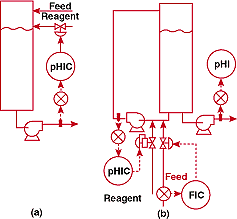
FIGURE 3. Where's the agitator? (a)-unsuccessful and (b)-successful pH control systems for a process involving an extremely tall mixing tank without an agitator
. Figure 3a shows how the pH was originally being controlled. Axial agitation probably would have corrected the difficulties, but could not be provided economically because the tank was too tall. A shorter tank would also have worked - again at a higher price than the plant wanted to pay. I decided that the best way to cope with the tank would be to use its volume as a filter, estimating that it would attenuate the hydrogen ion concentration oscillations of an in-line loop by a factor of 10,000 - 4 pH units. A circulation pump was installed as a low-deadtime in-line mixer. Influent and reagent were added to the new suction; an injector probe was installed on the pump discharge. The new system is shown in Figure 3b.
Upsets still occurred, due mainly to the quick opening characteristic and the large positioner hysteresis of the plug valve on the influent. However, the in-line pH loop returned rapidly to setpoint after a disturbance. Further, after passing through the tank volume, the pH drew the straightest line I have ever seen; for a moment, we thought someone had tied down the pointer. Performance was so good that the plant suggested we standardize on this type of system for pH control. I warned them that the setpoint of this system was several pH units below the neutral zone, on a relatively flat position of the titration curve. On a steep part of the curve, Fact of Life #2 would prevail and there would be lots of oscillations.
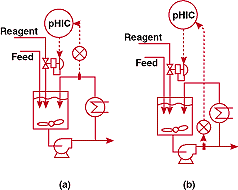
FIGURE 4. Where's the electrode? (a)-unsuccessful and (b)-successful pH control systems for a process in which electrodes have to be installed in inconvenient locations.
Where's the electrode?
I was called in to troubleshoot the pH system shown in Figure 4a. This simple configuration should have worked flawlessly, but was plagued by an unacceptably wide control band about the setpoint. I went down to look at the exit nozzle of the vessel and couldn't find the electrodes. I rapidly surmised that I had a major problem. In this case, the source of the difficulty was political. The instrument maintenance department had specified that the electrodes be located in the analyzer house, to avoid the discomfort of servicing them outside during the winter. Unfortunately, this location introduced excessive deadtime in the loop. To help avoid this problem in other situations, I feel compelled to state Fact of Life #7.
I succeeded in getting the electrodes moved by arguing about the extreme safety hazards and product quality problems that accompanied large pH excursions. The change, indicated in Figure 4b, narrowed the control band to about 0.1 pH.
We used injector electrodes for this application. Experience shows that these provide better performance and require less maintenance than sample chamber electrode holders. These benefits are especially evident when the electrodes are mounted in the discharge nozzle piping where fluid velocity is high - because the flow ensures rapid response by minimizing boundary layer thickness and prevents electrode coating by impurities in the stream.
Injection electrodes also appear to be less prone than sample chamber elements to leakage. In checking 30 installations of injection devices from one manufacturer, I found no instances of leakage; in fairness, when we obtained products from a different source, some leakage did occur. However, every sample chamber electrode holder I have ever encountered has eventually leaked. Moreover, leakage is visible with injector assemblies but not with sample chambers. For hazardous fluids, you don't want any surprises when you open the top cover of the electrode holder. This leads me to Fact of Life #8.
Is bigger better?
A plant used the system of Figure 5a for waste neutralization. The eductor shown in the figure had been added because mixing deadtime was too long. But even with this device, the deadtime appeared to be over 40 minutes. The consequent natural period of the pH loop was 160 minutes, so the maximum reset should have been less than 0.01 repeats per minute. Since this was below the minimum setting on the controller, the loop was in a continuous reset cycle; further, the integrated error - which is proportional to the deadtime squared - was out of this world. I looked at the engineering flow diagram and spotted the largest storage tank I had ever seen. I asked the process engineer where the neutralization tank was, and he pointed to the elephant I just thought was for storage. I immediately understood that I had major problem.
The intent of the large tank was plausible. It would serve to blend acidic and basic waste streams from different sources and minimize the reagent demand. Now, as long as you don't have to put control loops on them, large tanks are useful. Upstream of a control loop, a large tank can filter out disturbances and reduce reagent requirements; downstream, it can filter out loop oscillations - which is particularly advantageous because these fluctuations are usually faster than variations in influent concentration and are therefore more effectively attenuated. This reminds me of Fact of Life #9.
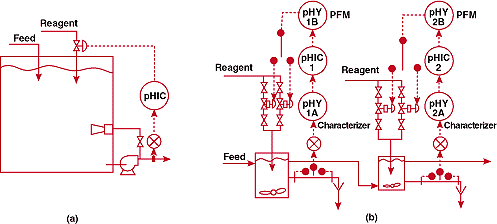
FIGURE 5. Is bigger better? (a)-unsuccessful and (b)-successful pH control systems for a process in which an extremely large tank was initially employed for mixing.
The new control system is shown in Figure 5b. The large tank was replace with two small vessels in series. A pulse frequency controller was installed to avoid valve pluggage at low reagent flows and to meet the extreme rangeability requirements imposed by the wide variations in influent flow and pH. Signal characterization was used to counteract the steep slope of the titration curve at the setpoint.
Startups are no fun without magical mystery. In this instance, we noticed that the pH measurement on the first tank was erratic. The problem could not be duplicated when we removed the electrodes and inserted them directly into the buffer solution or connected them to the measurement system of the second tank. We replaced the pH transmitter, preamplifier, cable, and electrodes individually but the erratic measurements continued. Eventually, someone remembered that the fiberglass preamplifier enclosure supplied by the manufacturer was replaced by the field maintenance department with a metal housing - to provide more room for access. The enclosure mounting plate was grounded. This created a second ground point in the circuit, and caused a significant current flow through the circuit. The problem did not occur on the second tank because the preamplifier housing was not mounted on a conductive structure. Likewise, the erratic behavior was not observed during buffering because the bottle was plastic. The problem was solved by isolating the preamplifier enclosure from ground with a plastic mounting plate.
The control system has performed well from startup except for periodic pluggage of the electrodes in an overflow sample line. Liquid head is too low to achieve a sample velocity sufficient to sweep the electrodes clean. A new electrode holder that provides a large flat electrode surface will be tried. If that doesn't work, we may have to shake loose enough money to install a sample pump and an injector electrode assembly.
Where's the reagent piping?
The pH in a neutralization tank was fluctuating in what appeared to be a square wave. The system was also subject to periodic glass electrode failures caused by etching and severe upsets due to a high-temperature interlock that sets due to a high-temperature interlock that shut off the reagent flow. Plant people were especially anxious to improve this system because reliability was critical to plant productivity. I stood at the top of the vessel wondering what to do, and noticed that the reagent was being transported by a conveyor rather than a pipe. I soon perceived that I had a major problem.
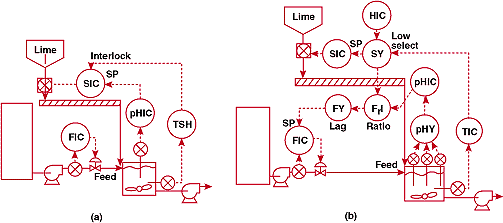
FIGURE 6. Where's the reagent piping? (a)-unsuccessful and (b)-successful pH control systems for a process iin which a powdered line reagent is delivered by a conveyor.
Figure 6a shows the original installation. The reagent, pulverized lime, was controlled by a rotary feeder at the discharge of the hopper. Feeder speed was set by the pH controller output. Reagent delivery was subject to several minute's lag due to transportation delay on the conveyor and solids dissolution time. We made precise measurements of the pH in the tank and found that the square waves were worse than the plant thought - the process instruments recorded only the high end of the pH scale, but the fluctuations actually covered almost the whole range from 0 to 14.
Luckily, a huge tank upstream of the waste flow provided enough inventory so the pH controller could be used to throttle the waste stream. The lime feeder speed was determined by selecting the lower of a manually-entered throughput setpoint and a command from the temperature override controller. The low signal selector therefore provided smooth transition between between normal and override control. The feeder speed signal is also multiplied by the pH controller command, passed through a lag unit whose delay is set equal to the reagent delivery time, and fed forward to establish the waste flow setpoint.
To eliminate downtime due to electrode failures, a system was installed using three measuring elements and voting logic to establish the output signal. Use of three rather than two electrode assemblies make it possible to determine which signal to use, if the electrode outputs disagree. This leads me to Fact of Life #10.
Control improved dramatically. Electrode failure due to etching, which had occurred when the solution was acidic - at the unrecorded lower portion of the square wave - also stopped. And use of voting logic to control using three electrode assemblies has virtually eliminated downtime, even when an element becomes nonfunctional.
USING YOUR SKILLS
One of the prices you pay for being an instrumentation expert in the processing industries is that occasionally, someone will ask you to control pH. The job rarely proves to be easy, for instance because you are on a flat portion of the titration curve or have wide tolerance on response and accuracy, because changes are then high that someone has done it satisfactorily without you. So the problems you get are usually major problems. You'll have to call on all you know about the installation and operation of electrodes, control valves, piping, and mixing equipment. You'll have to brush the cobwebs off your basic understanding of feedback and feedforward loop strategies. You'll have to home your skills as a diplomat to get the plant to install, replace, or eliminate vessels or instruments that make life convenient for the operators or maintenance people - or represent investments for which somebody has a neck on the line - but are preventing satisfactory pH control. And you'll have to resign yourself to living out of your suitcase for a while while the plant starts up and experiences the magical mystery of pH.
REFERENCE
1. McMillian. G K; pH Control. Independent Learning Module Series, Instrument Society of America (Research Triangle Park NC), 1964.
© Instruments Society of America. Intech, September, 1984. All rights reserved.
 |
|
  |
|